Witch Hazel
Plants we love
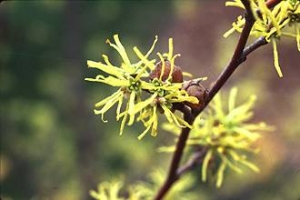
Hamamelis virginiana
By Marsha Goldberg, Fairfax Master Gardener
In the late fall and the depth of winter, when it is cold and snowy, it may be easy to forget how quickly the warm weather will return. Luckily, Mother Nature has given us witch hazel, the perfect plant to perk us up on dull days and serve as a harbinger of spring. Witch hazel, or hamamelis, blooms in an array of shades, from bright yellow to deep red, and provides a cheerful spot of color against the dark greens and deep browns of the winter season. The leaves have beautiful colors as well, and when you walk by the plant’s blooms, they will reward you with their intoxicating fragrance.
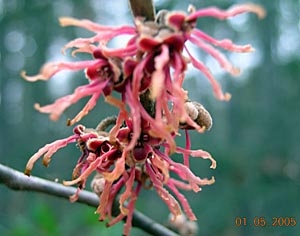
Big-leaf witch-hazel (Hamamelis ovalis)
Types of witch hazel
There are four major species of witch hazel: Hamamelis virginiana and H. vernalis, which are both native to North America; H. mollis (Chinese witch hazel); and H. japonica (Japanese witch hazel). A fifth species, H. ovalis (big-leaf witch hazel), was only just discovered and described in 2004 in a small area of Mississippi, the only area in which it seemed to exist at the time. There are dozens of cultivars, however, many the outcome of crossing the two Asian species, resulting in Hamamelis _ intermedia. The colors of the witch hazel blossoms depend on the species. All are fragrant, although opinions vary as to which are the most fragrant species. Asian cultivars do not have the advantages that are typical of native plants, but the H. intermedia has been bred to do well in our area, despite that fact that the parent plants are a bit less hardy.
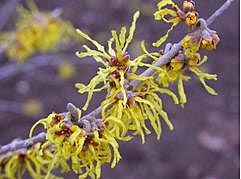
Arnold’s Promise
Three-season interest
Gardeners value witch hazel for its fragrance and for color from blooms and leaves during three seasons. The flowers are hardy even during a frost or an extremely cold period. During the warmer months, their spicy fragrance attracts pollinators. H. virginiana blooms in the late fall, while H. vernalis and the Asian species bloom in winter to early spring, so planting a variety will give you continuous color throughout the cold season. They can grow as large shrubs or small trees, usually reaching 10 to 20 feet tall and becoming just as wide, although you can prune them to remain smaller.

Witch hazel tolerates partial shade
Planting considerations
Witch hazel is hardy from zones 5 to 8. The plants grow well in moist, loamy, acidic soil so if your soil is mostly clay, as is common in our area, consider amending it. Witch hazel does not do well in drought conditions, so mulch around the roots to keep them moist. Make sure you give them plenty of water when you first plant them. Witch hazels grow best in partial shade but can do well in full shade or full sun. Too much shade may cause them to get leggy, while too much sun may scorch the plants. They will, however, produce more blooms in the sun, so factor that in when choosing a spot for them. The best time to prune witch hazel is immediately after it flowers, before the summer. Unfortunately, while most pests do not bother witch hazels, deer are happy to munch on them, so take some steps to protect them. See Outsmarting Deer in the Landscape for suggestions.
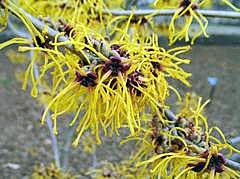 Barmsteadt Gold 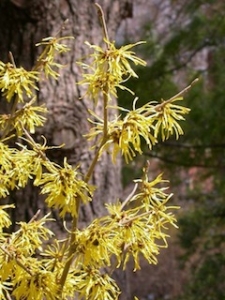 Westerstede |
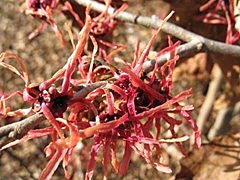 Livia |
Resources & References
• Which witch hazel should be in your yard?, Chicago Botanic Garden, (2015)
• Witch hazel, Chicago Botanic Garden, (2015)
• The Layered Garden, D. Culp, and A. Levine, Timber Press, Inc. (2012)
• Big-leaf witch hazel (Hamamelis ovalis), K. Gordon, United States Department of Agriculture
Forest Service
• Witch Hazel, Missouri Botanical Garden
• American Witchhazel (Hamamelis virginiana L.), Stritch, L., United States Department of Agriculture
Forest Service
• Hamamelis virginiana L. American Witchhazel, United States Department of Agriculture Natural
Resources Conservation Service, PLANTS Database